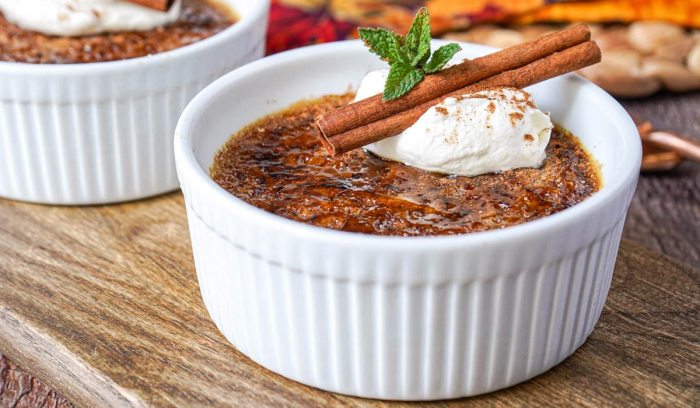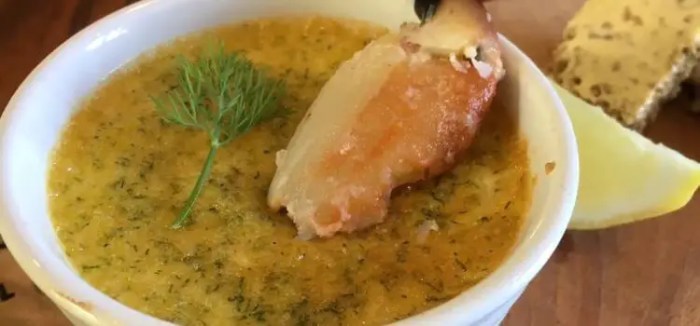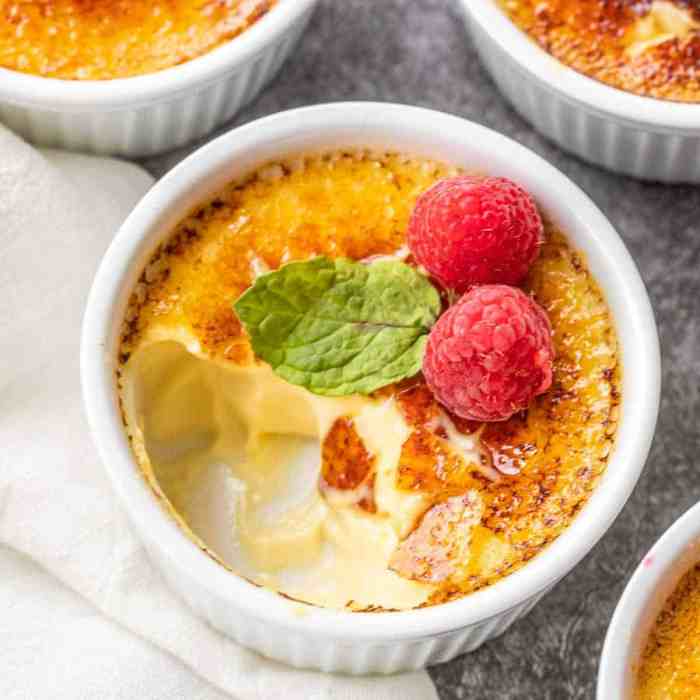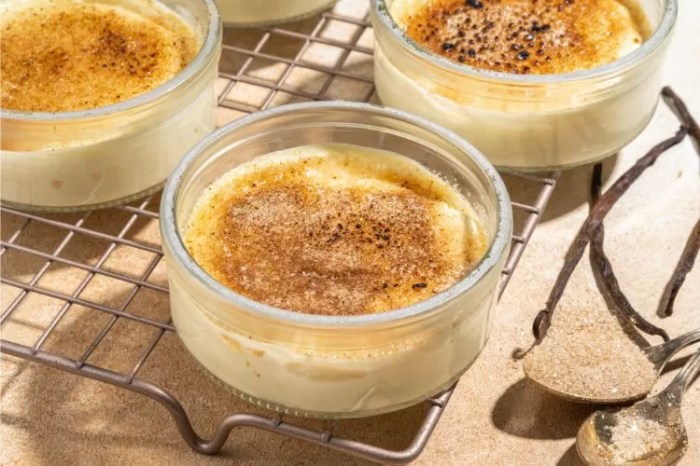
Prepare to embark on a culinary adventure with our captivating crab brulee recipe. This exquisite dish harmoniously blends the succulent flavors of crab with the velvety richness of custard, creating a symphony of textures and flavors that will tantalize your taste buds.
Our detailed guide will guide you through every step of the preparation, from gathering the finest ingredients to mastering the delicate cooking techniques. Discover the secrets of achieving the perfect balance of flavors and textures, resulting in a dish that will leave an unforgettable impression on your palate.
Ingredients and Preparation

To create a delectable crab brulee, gather the freshest ingredients. You’ll need succulent crab meat, rich cream, velvety butter, aromatic shallots, pungent garlic, vibrant bell peppers, and a hint of Old Bay seasoning. Additionally, you’ll require ramekins, a kitchen torch, and a dash of patience.
Begin by sautéing the shallots and garlic in melted butter. When they’re softened, add the diced bell peppers and cook until they’re tender. Stir in the crab meat and Old Bay seasoning, ensuring every morsel is coated in flavor. In a separate bowl, whisk together the cream and eggs.
Are you looking for a delicious and easy way to cook chicken of the woods? Look no further than the chicken of the woods recipe from Northampton. This recipe is simple to follow and yields a flavorful and juicy dish.
Whether you’re a seasoned chef or a novice in the kitchen, you’ll be able to whip up this delectable meal in no time.
Season with salt and pepper, then combine the crab mixture. Divide the mixture evenly among the ramekins.
Bake the ramekins in a water bath until the custards are set. Remove from the oven and let cool slightly. Before serving, sprinkle the tops with grated Parmesan cheese and caramelize with a kitchen torch. The result is a symphony of flavors and textures that will tantalize your taste buds.
Fresh Ingredients
Using fresh ingredients is paramount. Fresh crab meat yields a sweet, delicate flavor, while stale crab can impart a fishy taste. High-quality cream and butter provide richness and depth, and fresh vegetables add vibrancy and crunch. By investing in fresh ingredients, you elevate the dish to its full potential.
Cooking Techniques
The crab brulee recipe employs several cooking techniques that work together to create its unique flavor and texture. These techniques include steaming, searing, and baking.
Steaming the crabmeat helps to preserve its delicate flavor and texture while cooking it evenly. Searing the crabmeat in a hot pan adds a layer of crispy flavor to the dish. Finally, baking the crab brulee in a water bath helps to create a smooth and creamy custard.
Steaming
Steaming is a gentle cooking method that uses steam to cook food. This method is ideal for delicate foods like crabmeat, as it helps to preserve their flavor and texture. To steam the crabmeat, place it in a steamer basket over a pot of boiling water.
Cover the pot and steam the crabmeat for 5-7 minutes, or until it is cooked through.
Searing, Crab brulee recipe
Searing is a cooking technique that involves browning the surface of food in a hot pan. This technique adds flavor and color to the dish. To sear the crabmeat, heat a tablespoon of oil in a large skillet over medium-high heat.
Add the crabmeat to the skillet and cook for 2-3 minutes per side, or until it is golden brown.
Baking
Baking is a cooking method that uses dry heat to cook food. This method is ideal for creating a smooth and creamy custard. To bake the crab brulee, preheat the oven to 350 degrees Fahrenheit. Place the crabmeat mixture in a baking dish and bake for 20-25 minutes, or until the custard is set.
Presentation and Garnish

The presentation of your crab brulee is crucial in elevating the dining experience. By arranging the brulees elegantly and incorporating complementary garnishes, you can create a visually appealing and tantalizing dish that will impress your guests.
When plating, consider using individual ramekins or small serving bowls. Arrange the brulees neatly, ensuring they are level and have a smooth surface. To add height and drama, place the brulees on a bed of fresh greens, such as watercress or arugula.
Garnishes
Garnishes play a vital role in enhancing the flavors and visual appeal of your crab brulee. Choose garnishes that complement the delicate flavors of the crab and the sweetness of the brulee topping. Some elegant options include:
- Fresh herbs, such as chives, dill, or parsley, add a pop of color and freshness.
- Citrus zest, such as lemon or orange, provides a bright and tangy contrast.
- Microgreens, such as pea shoots or sunflower sprouts, add a touch of texture and vibrancy.
- Edible flowers, such as pansies or violas, bring a touch of elegance and sweetness.
Arrange the garnishes carefully on top of the brulees, ensuring they do not overpower the delicate flavors. A sprinkle of paprika or a drizzle of olive oil can also add a touch of sophistication.
Variations and Adaptations: Crab Brulee Recipe

The classic crab brulee recipe is a versatile dish that can be adapted to suit various tastes and dietary needs. Experimenting with different crab types, incorporating additional ingredients, and making adjustments for specific preferences can elevate the dish to new heights.
If you’re looking for a more adventurous twist on the classic chicken of the woods recipe, check out the version from Madison. Their recipe incorporates a unique blend of spices and herbs that will tantalize your taste buds. The chicken of the woods recipe from Madison is sure to become a favorite in your culinary repertoire.
One popular variation is using blue crab instead of Dungeness crab. Blue crab has a sweeter, milder flavor that pairs well with the creamy custard base. For a richer taste, consider using a combination of blue crab and Dungeness crab.
Dietary Adaptations
For those with shellfish allergies, crab can be substituted with other seafood options such as shrimp or lobster. The cooking techniques and flavor profiles remain largely the same, ensuring a delicious and allergy-friendly alternative.
To cater to vegan or vegetarian preferences, the crab can be replaced with plant-based ingredients such as tofu or jackfruit. These substitutes provide a similar texture and absorb the flavors of the custard, creating a satisfying and flavorful dish.
Additional Ingredients
Incorporating additional ingredients can enhance the flavor and visual appeal of crab brulee. Consider adding sautéed mushrooms, diced bell peppers, or a sprinkle of fresh herbs such as chives or parsley. These ingredients add depth, texture, and vibrant colors to the dish.
For a touch of sweetness, a drizzle of honey or maple syrup can be added to the custard before baking. This creates a caramelized crust that complements the savory flavors of the crab.
Culinary History and Cultural Significance

Crab brulee traces its roots to the coastal regions of France, where it emerged as a culinary delight in the 18th century. The dish is believed to have originated in the kitchens of Normandy, a region renowned for its seafood delicacies.
Evolution of Crab Brulee
Over the centuries, crab brulee has evolved from its humble beginnings into a sophisticated dish. Initially, it was prepared using a simple combination of crab meat, eggs, and cream, baked in a shallow dish. However, as culinary techniques advanced, chefs began experimenting with different ingredients and flavors, resulting in a diverse range of variations.
Cultural Significance
Crab brulee holds a significant place in French cuisine, particularly in coastal regions. It is often served as an appetizer or main course, accompanied by a variety of sides and sauces. The dish has also gained popularity in other parts of the world, with chefs adapting it to suit local tastes and preferences.
Influence on Culinary Trends
Crab brulee has influenced culinary trends in several ways. Its creamy texture and rich flavor have inspired the creation of other seafood-based brulees, such as lobster brulee and shrimp brulee. Additionally, the dish has contributed to the growing popularity of brulee as a culinary technique, with chefs experimenting with various ingredients and flavor combinations to create unique and innovative desserts.
Epilogue

Whether you’re a seasoned chef or a culinary novice, our crab brulee recipe will empower you to create a dish that will impress your guests and elevate your dining experience. Experiment with variations and adaptations to tailor it to your preferences and dietary needs.
As you savor each delectable bite, remember the culinary history and cultural significance of this extraordinary dish, a testament to the enduring power of culinary innovation.
Popular Questions
What type of crab is best for crab brulee?
Blue crab, Dungeness crab, or king crab are all excellent choices due to their delicate and sweet flavor.
How can I make a gluten-free crab brulee?
Substitute gluten-free flour for all-purpose flour in the crust and use almond milk instead of regular milk.
Can I prepare crab brulee ahead of time?
Yes, you can assemble the brulee up to 24 hours in advance and refrigerate it until ready to bake.





